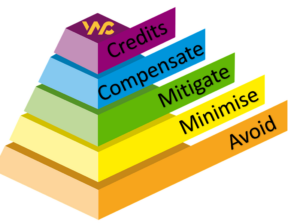Introduced by the groundbreaking Environment Act 2021, biodiversity net gain will be legally implemented in January 2024 for all major developments and April 2024 for minor developments.
During our Biodiversity Net Gain Breakfast Briefing event last month, Jack Potter, Director at Wild Capital, gave our attendees an insightful introduction to biodiversity net gain. Here are some of the key areas he covered, as well as our take on the planning aspects of biodiversity net gain.
What is biodiversity net gain?
If you’re not too familiar with the term, biodiversity net gain (BNG) is a way to contribute to the recovery of nature while developing land. It’s about ensuring the habitat for wildlife is in a better condition than it was before development.
Who will be affected by mandatory BNG?
Mandatory BNG will have implications if you’re a:
- Land manager/owner
- Developer
- Local planning authority
How can you calculate the BNG of a development?
The BNG of a development can be assessed using the BNG metric. The metric is a unit of measurement used to evaluate the ecological value of a site.
The BNG metric is a step change for biodiversity as it values all habitats. Even those of low value and includes area-based features such as woodland, as well as linear features such as hedgerows, rivers, and streams. It doesn’t include specific species impacts, so the need for bat and bird boxes will likely be in addition to the metric.
Mitigation Hierarchy
Embedded within the BNG metric is the Mitigation Hierarchy. The Mitigation Hierarchy is a tool to help users limit the potential harm of development to habitats and puts avoidance of harm as the number one priority. The inner workings of the BNG metric incentivise biodiversity provision that is onsite or ‘close by’.
Here’s what the hierarchy includes:
- Avoid the impact
- Minimise the impact by designing to avoid valuable habitats
- Mitigate the impact onsite by enhancing and creating habitats onsite
- Compensate offsite by delivering biodiversity schemes offsite and nearby
- Last resort – statutory credits from Natural England

Image credit: Wild Capital
What does all of this mean for your development project?
The baseline is key! To find a successful route through the BNG metric, you should assess the site as soon as possible. If you do this within the design phase of the project, you can identify habitats early on and manage the risk.
During this process, it’s important to avoid the loss of high-value habitats, such as woodland. This ensures you create a balance in the BNG metric. On small development sites, your opportunities to achieve gains may be limited – so it’s important to be realistic. For example, can a highway verge be maintained as a lowland meadow?
If you’re planning to extend a site to provide more room for biodiversity enhancement, this should be carefully considered because increasing the site area will, as a result, increase the baseline value of the site and the required enhancement. On some small sites, it will be more pragmatic and cost-effective to offset through a local habitat bank scheme.
On large strategic sites, there will be opportunities to provide multifunctional green space, including habitat enhancement, sustainable drainage systems, nutrient neutrality, recreation, and nature-based solutions.
The last resort…
National statutory credits should be the last resort. They require two credits to be purchased for each habitat unit to be offset.
Opportunities for landowners
As mandatory BNG approaches, we’re seeing a significant increase in activity surrounding the creation of habitat banks and markets. Some local planning authorities are piloting habitat banks directly, whilst national habitat banks have been acquiring sites across the country to provide national coverage of potential offsetting sites.
With changes to farm subsidies set to continue and estimated profits of around £3k – £4k per hectare per year – mandatory BNG could be a great opportunity for landowners.
What could impact opportunities for landowners?
Opportunities will depend on the land available. Arable land is a great starting point, but it’s not just about the type of land you have, the level of demand and existing competition in your area are key considerations. For instance, submitting a proposal for a 500 BNG unit farm to a local planning authority with a demand of 10 BNG units per year is completely pointless.
As well as these factors, there are other considerations that should be evaluated. BNG projects are a multigenerational commitment of at least 30 years when there is an upfront payment. Conservation covenants would be applied to the land and the responsibility for maintaining the BNG will ultimately fall to the landowner. So, you will need to think carefully about the location and management of the land.
“It was a real pleasure to present biodiversity net gain to Edgars’ attendees. We understand the challenges for developers in this current climate and are always willing to offer our expertise.”
– Jack Potter, Director, Wild Capital
The future of BNG in planning
With emerging planning policies requiring up to 20% BNG and delivery of maximum BNG on site, how will planning decisions weigh up the delivery of BNG onsite against the delivery of the development?
The emphasis on BNG has risen significantly within planning judgements and highlights the continued need for engagement with local planning authorities throughout the pre-application and decision-making process.
The same judgements will need to be made at the local plan allocation stage. There will most likely be a need for BNG assessments as part of site submissions and local plan preparation for local planning authorities to assess what a deliverable quantum of development is for a site allocation.
BNG is far from just a metric, it’s now an elevated part of the planning judgement and requires assessment and engagement from the very outset.
If the upcoming mandatory BNG seems a little overwhelming – our team of trusted professionals can help guide you through the process and keep your development project on track. Get in touch with us on 01865 731700 or email enquiries@edgarslimited.co.uk.
For more information on mandatory BNG, see the Government’s Biodiversity Net Gain moves a step closer page.
You might also be interested in reading: Local authorities leading the way on net zero carbon development

